
Uzbekistan
For a full scale picture, please click on the picture shown !
Uzbekistan National Railways - Uzbekiston Temir Yullari
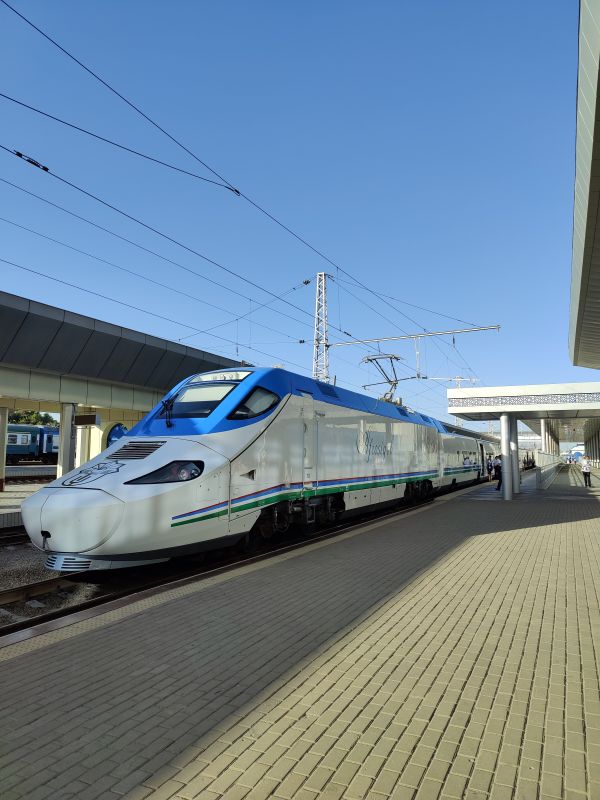
A Talgo train of Uzbek Railways seen here at Tashkent airport station. Uzbek Railways call these trains Afrosiyob trains.
Picture by Timo Varshukov 18.8.2022.
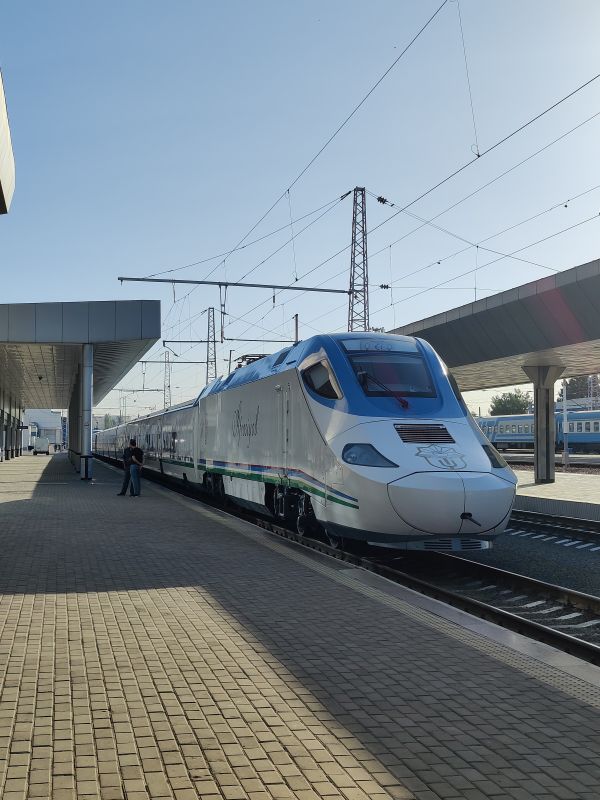
Another view of an Afrosiyob Talgo train of Uzbek Railways.
Picture from Tashkent airport station by Timo Varshukov 18.8.2022.

Loading business class passengers' cargo goods onto an Afrosiyob train.
Picture from Samarkand station 13.9.2022 by Markku Salo.
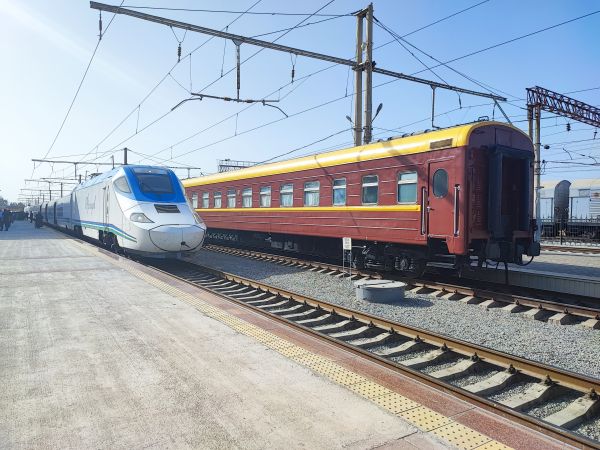
New and old side by side. There are still some of these old Soviet times sleeperette wagons left in old Soviet style colours.
Picture from Samarkand station 13.9.2022 by Markku Salo.
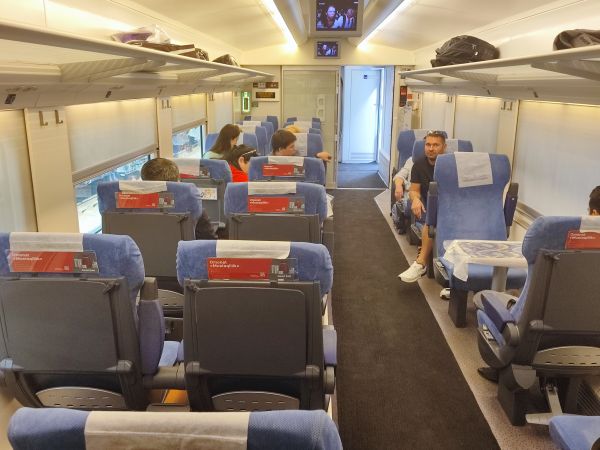
Inside view of one of the Uzbek railways' Afrosiyob Talgo trains. This is the business class.
Picture 13.9.2022 by Markku Salo.
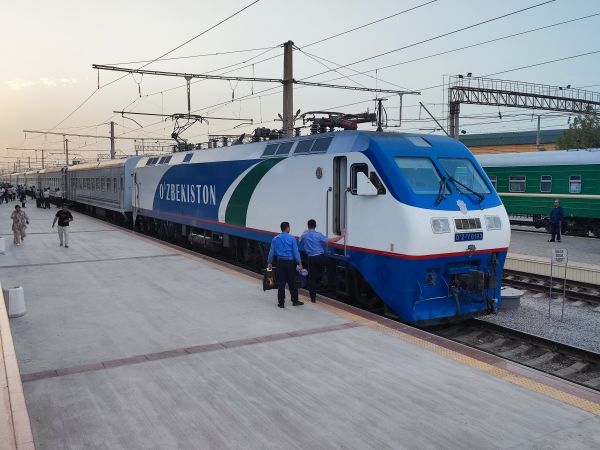
Uzbekistan railways electric locomotive of the class O'Z-Y in front of the luxury train "O'zbekiston". These six axle locomotives
have been built by the Chinese company CRRC. It's designed for 25kV AC electricity and 1520mm gauge tracks. Its power rating is
6000 kW.
Picture from Samarkand station 11.9.2022 by Markku Salo.
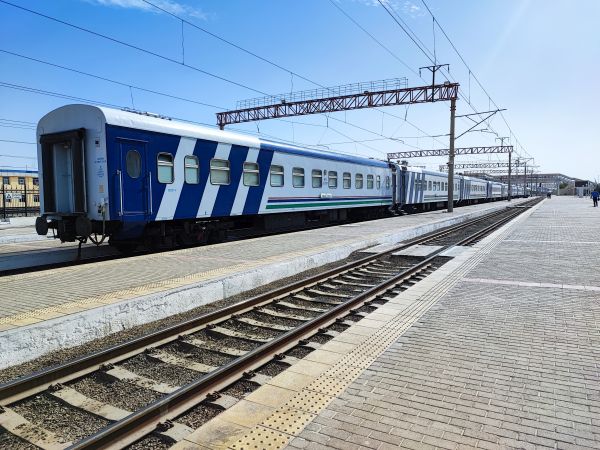
Thoroughly modernised old Russian coaches, now as a part of the luxury train "O'zbekiston"
Picture from the "Bukhara 1" station in Kogon 11.9.2022 by Markku Salo.
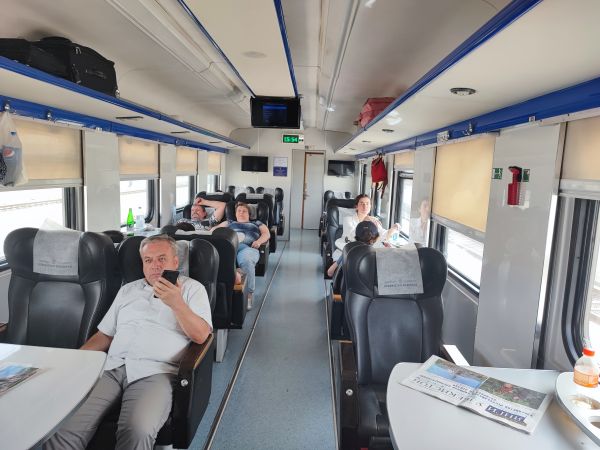
Inside view of a first class coach of the luxury train "O'zbekiston".
Picture 11.9.2022 by Markku Salo.
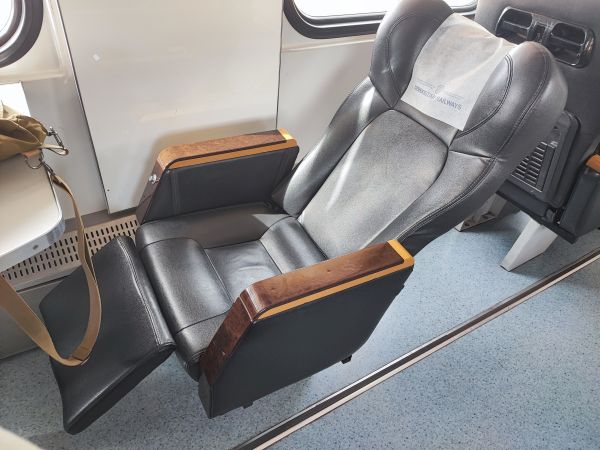
The seat of a first class coach of the luxury train "O'zbekiston". These coaches are old, but very recently totally modernised and rebuilt
for this luxury train service.
Picture 11.9.2022 by Markku Salo.
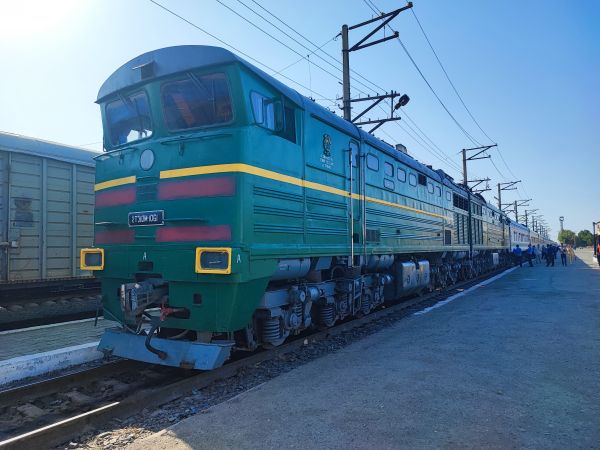
More than enough power for a passenger train? An old class 2TE10M double locomotive in front of a regular passenger train. These locomotives
are from the early 1960s and the machine carries still the classical colours used throughout the Soviet Union. But the "M" in the locomotive
class name 2TE10M stands for "modernised".
Picture from Kungirot station 11.9.2022 by Markku Salo.
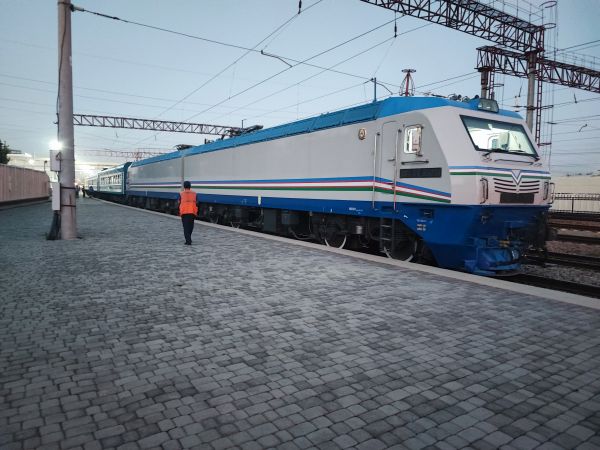
Definitely more than enough power for this short passenger train. This is a new double locomotive of the Uzbekistan railways class 2O'Z-OY
which has a power rating of 9600 kW. Should be enough to pull three old Soviet time coaches ! Uzbekistan railways has ordered 30 of these huge
new locomotives from China, where they are being built by a consortium of three companies, CNTIC, CRRC and DRLOCO. The main manufacturer is
CRRC Dalian.There are two versions of these machines and this is the cargo-passenger version which has "only" eight axles and 9,6 MW of power.
The cargo version has twelve axles and a power rating of 12,2 MW. All these new locomotives will be built and delivered during the period 2021-22.
Picture from Tashkent station 11.9.2022 by Markku Salo.
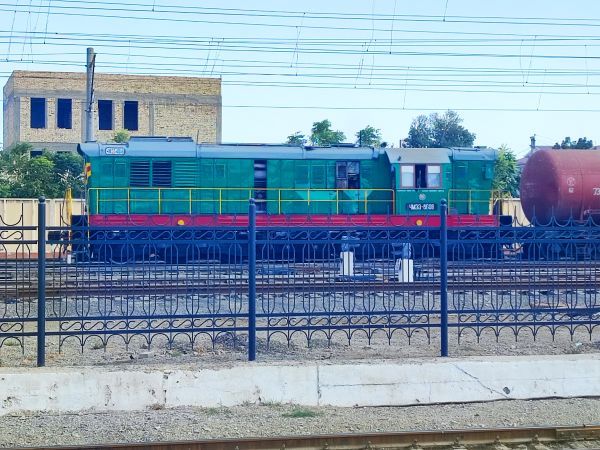
A trusted old workhorse in a recetly modernised condition, this is a ChME3 cargo locomotive dating back to the old Soviet Union
times.
Picture from the station "Bukhara 1" in Kogon 11.9.2022 by Markku Salo.
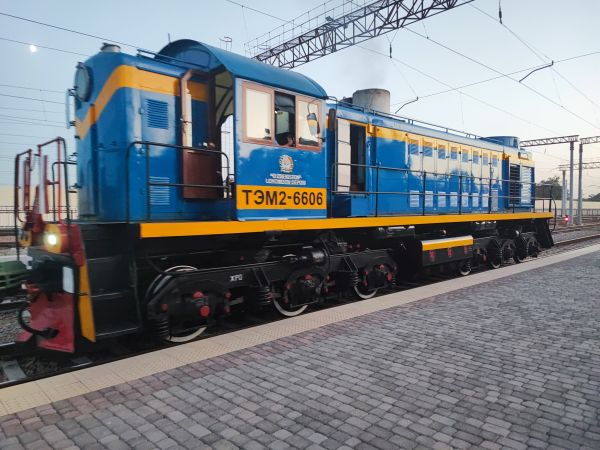
It looks brand new, but it's just thoroughly modernised. This is a class TEM2 shunter from the 1970s, a very common machine in the former Soviet
Union. They are essentially reverse-engineered, Russian built copies of US made Alco RSD-1 locomotives, which the US army sent to Soviet Union
during World War II. The Russians just basically copied the machine as best as they could, changing all the bolts built in inches to millimeter
scale ones. The result was a very robust engine, which the Russians kept building until the 1970s and which now after many modernisations is
still a good tool.
Picture from Tashkent station 6.9.2022 by Markku Salo.
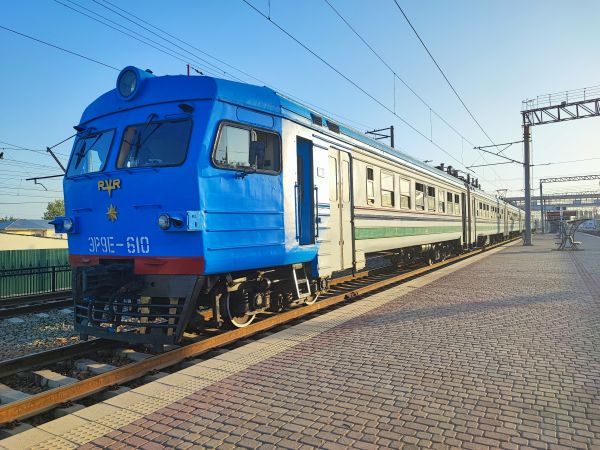
It's in brilliant condition, but it's pretty old already. These EMU trains which were built by RVR in Riga, Latvia, used to be commonplace all
around the Soviet Union. The 3 kV DC version was called ER2 and the 25 kV AC version was named ER9. This version ER9E is from the year 1981.
It's a modified version with for example newer bogies and it's intended for longer suburban and regional trains than the original ER2/ER9 was.
Uzbekistan Railways published in May 2021 a story where they said they are in the process of evaluating various new trains to replace these
ER9E units in the near future. Uzbekistan Railways uses these mainly in the suburban traffic around Tashkent.
Picture from Tashkent station 6.9.2022 by Markku Salo.
Tashkent metro
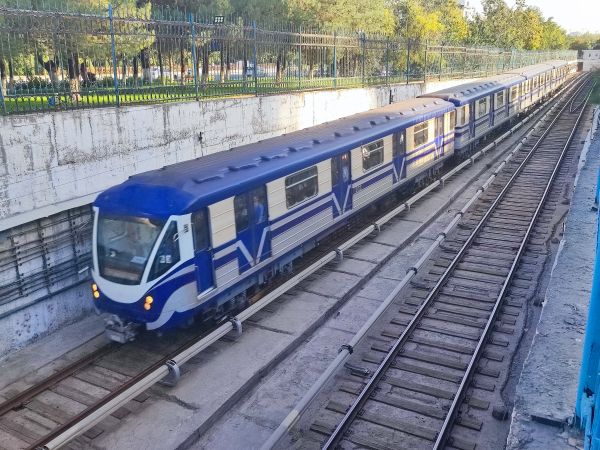
Tashkent's metro system (Toshkent metropoliteni) has been built to run very near the ground and in certain places on the ground. Here we see a train
of the red line (Chilonzor Line) approaching the station of Amir Temur Hiyoboni. Tashkent's metro system consists of four lines with a total length
of some 59 km. The operator of the system is Uzbekistan's national railways Oʻzbekiston Temir Yoʻllari. The trains operate with 825V DC from a third
rail. The train that we see here is a modernised version of the type 81-717/714 built by the Russian company Metrowagonmash. These were originally
built from 1984 to 1994, but they have been totally renovated and rebuilt 2012-13.
Picture from Amir Temur Avenue, Tashkent, 14.9.2022 by Markku Salo.
Trams of Samarkand

Samarkand is now the only city in Uzbekistan which has trams. Tashkent used to have a tram system with six lines, but it was closed in 2016 and all
trams were sold because the mayor of Tashkent wanted to get rid of trams to get more space for private cars (!!). So the trams were all sold and/or
scrapped. These Vario LF (variable low-floor) trams from the year 2011 used to be the newest and best trams of Tashkent. Samarkand bought them all
and built a new tram system using only these trams. It opened for passengers in 2017, just one year after the closure of the Tashkent system. In
Samarkand there was initially just one 6,4 km line from the train station to Sartepa Massivi but then a new, additional route from the train station
to the Siab Bazaar was opened in 2018. The rolling stock consists of 18 of these Vario LF trams. These Vario LF trams were not totally new when they
were produced in the Czech Republic in 2011, but they were rebuilt old Tatra T3 trams. The technology is still from the ancient Tatra. In addition
to Samarkand, they are also used in Olomouc, Brno and Ostrava in the Czech Republic and in Moscow in Russia.
Picture of a Vario LF tram at the Samarkand station 11.9.2022 by Markku Salo.

